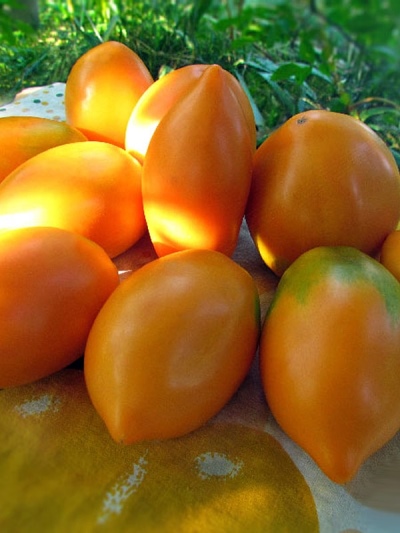
- Authors: Dederko V.N., Postnikova O.V.
- Year of approval: 2008
- Name synonyms: Radunica
- Category: grade
- Growth type: indeterminate
- Appointment: universal
- Ripening period: mid-season
- Ripening time, days: 110-120
- Growing conditions: for open ground, for film greenhouses
- Transportability: good
Fans of amber tomatoes, which attract not only by their appearance, but also by their excellent taste, will certainly like the mid-season tomato variety Radunitsa, which is productive both in the garden bed and under a film cover.
Breeding history
Radunitsa tomatoes were created by domestic breeders O. V. Postnikova and V. N. Dederko in 2007. The culture was included in the State Register of Russian varieties for garden plots in 2008. Recommended for growing tomato in all regions of the country. The variety is maximally productive, growing under film shelters.
Description of the variety
Vegetable culture Radunitsa is a medium-sized plant of an indeterminate type. The bushes, which grow up to 160 cm in height, are characterized by moderate thickening with rich green foliage, an erect central stem, medium branching, a developed root and simple inflorescences. The first fruit cluster appears above 7-9 leaves. 4-5 berries are formed in each fruit cluster.
When growing, it will be necessary to form bushes of 1-2 stems, regular removal of stepsons and a garter to the supports. Thinning of leaves in the lower part of the bush is carried out as needed. The purpose of tomatoes is universal - they are eaten fresh, processed into sauces, pickled and canned. The smallest fruits are suitable for whole fruit canning.
The main qualities of the fruit
The Radunitsa tomato is a class of large-fruited nightshade. The average weight of a vegetable is 208 grams, but under favorable conditions tomatoes grow up to 300-350 g. The shape of the fruit is unusual - obovate, resembling a flattened pear or rocket. The color of the vegetable is very beautiful - rich yellow, sometimes amber. At the stage of technical maturity, the fruits turn green with a characteristic spot at the base. The tomato peel is smooth, shiny, of medium density. The resistance of the tomato to cracking is present. In addition, tomatoes tolerate transportation and long shelf life well.
Taste characteristics
The taste and marketability of the vegetable is excellent. The tomato pulp is tender, fleshy, medium density, slightly sugary and very juicy. There are few seeds in the pulp, no wateriness is observed. The taste of the tomato is harmonious, sweet-sugar with a subtle sourness. The aroma of the vegetable is moderate - dessert-spicy.
Ripening and fruiting
Tomatoes are mid-season. From the moment of germination to full ripening of the berries on the bushes, it takes about 4 months - 110-120 days. Tomatoes spice up together, so you can harvest with whole fruit clusters. The active phase of fruiting occurs in the period from the second half of July to the end of August.
Yield
The yield indicator of the variety is impressive. Observing basic agricultural techniques, 12.8 kg of tomatoes can be grown and harvested per 1 m2. On average, about 3.5 kg of amber berries are removed from one bush.
The timing of planting seedlings and planting in the ground
Grow nightshade culture through seedlings. Sowing seeds is carried out 50-60 days before planting in the garden. The best season for sowing is the end of March. Seedling germination occurs on the 5-7th day. For the growth of bushes, optimal temperature and light conditions should be provided. The greenhouse effect will accelerate germination - covering the boxes with seeds with glass or polyethylene.At the stage of the appearance of 2 leaves, the bushes need to be planted in separate pots, which will allow the root system to get stronger. After diving, the seedlings are watered and fed. 10 days before the transfer of the bushes to a permanent place, it is recommended to carry out preparation - to harden the plants, exposing them to fresh air every day.
You can plant seedlings on the garden bed at the stage of appearance of 5-7 leaves and one flower brush. As a rule, bushes are transplanted at the age of 50-60 days.

Growing tomato seedlings is an extremely important process, because it largely depends on whether the gardener will be able to harvest at all. All aspects must be taken into account, from seedbed preparation to planting in the ground.
Landing scheme
It is important not only to water and feed the tomatoes, but also to plant them correctly in the garden. You can plant 3-4 bushes per 1 m2, which will allow each plant to receive the right amount of air and light. Recommended for planting is a 50x70 cm scheme.

Growing and care
Tomatoes are not capricious in their care, but they love loose, fertile and breathable soil. The site should be well lit by the sun and have a neutral acidity. Care includes: watering, fertilizing, weeding the soil, shaping, pinching and tying bushes, as well as preventing viruses.




A plant needs different micronutrients at each stage of growth. All fertilizers can be divided into two groups: mineral and organic. Folk remedies are often used: iodine, yeast, bird droppings, eggshells.
It is important to observe the rate and period of feeding. This also applies to folk remedies and organic fertilizers.
Disease and pest resistance
The plant has good immunity, but preventive treatments are recommended, since the tomato can sometimes undergo apical and root rot, as well as fusarium wilt. By controlling soil moisture, as well as ventilating the greenhouse room, phytophthora outbreaks can be avoided.


Resistant to adverse weather conditions
The variety has high stress resistance. Tomato tolerates temperature fluctuations, short-term drought and heat. Does not take shade and excessive moisture very well.

























































































